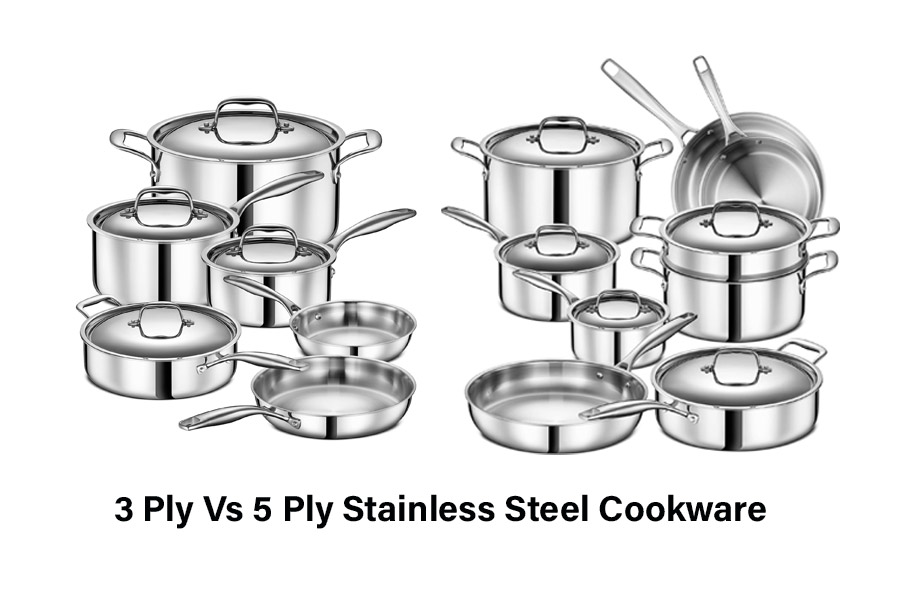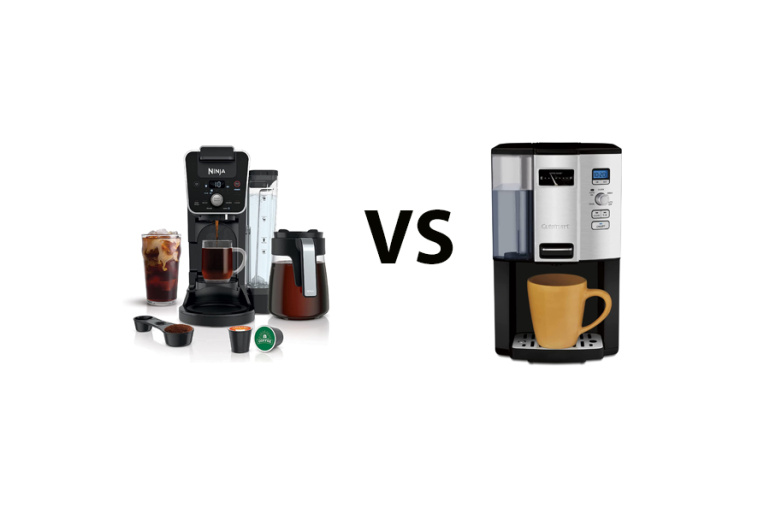If you have spent some time online searching for stainless steel cookware, then you have come across the terms “3-ply” and “5-ply.” But what makes most people confused is which one to choose.
To help you understand which one is the right one for 3 ply vs 5 ply stainless steel cookware, we have identified various differences based on various factors and also mentioned the impact of increasing the number of plys.
Contents
What Does Cladding Mean?
“Cladding” describes the many metal layers and construction methods used in 3-ply and 5-ply cookware.
Cladding, in this context, refers to the process of bonding metal core materials—usually aluminum or copper—between stainless steel external layers. Stainless steel has a long-lasting, nonreactive exterior, while the inner core is great at distributing and conducting heat.
Important Notes
- Cladding often uses either three or 5-ply, where ply is the number of metal layers.
- If you want your cookware to retain heat evenly and effectively, go for clad cookware that has layers linked together all the way around.
- You can get clad cookware at a lower price, but it may only be clad on the bottom with inferior disk or composite layers instead of a complete bond.
Stovetop Compatibility
3 Ply:
- Suitable for use with various kinds of stovetops, including ceramic, induction, gas, and electric
- Comprehensive induction functioning is enabled by the magnetic outer layer.
5 ply:
- Having an excessive amount of iron might restrict its usage over open gas flames.
- Glass and ceramic ranges are not usually suggested for use.
Reaction to Temperature Changes
3 Ply:
- When the temperature dial is changed, the higher conductive core changes its temperature swiftly.
- When necessary, it is quicker to heat up or cool down.
5 ply:
- Layers with a greater density have a slower reaction to dial changes.
- It is more difficult to adjust the level of heat.
Food Browning
3 Ply:
- Browning and fondness of food are more obvious through thinner layers.
- Serves as a measure for doneness and deglazing.
5 ply:
- More substantial content makes it difficult to see the development of fondness.
- Not as easy to keep an eye on browning or cultivate fondness.
Ease of Cleaning
3 Ply:
- Having fewer layers and smoother surfaces makes cleaning simpler and more thorough.
- Any residues left over after cooking may be easily removed by scrubbing.
5 ply:
- A complex five-layer structure results in an increased number of fissures.
- To remove residues, more scrubbing may be required.
Heating Consistency
3 Ply:
- Generally speaking, aluminum and copper cores can transmit heat uniformly, which permits consistent cooking.
- However, because of the thinner design, some stovetops may have hot patches here and there.
5 ply:
- Adding more layers results in the most uniform dispersion of heat.
- Across the whole surface, there are no places that are cold or scorching.
Cooking Efficiency
3 Ply:
- Less heat energy is needed to achieve cooking temperatures when the structure is thinner.
- Able to heat up more quickly and need less time to preheat
5 ply:
- More heat energy is required to attain the desired temperature for a heavier structure.
- Preheating periods often need to be longer.
Balance and Handling
3 Ply:
- Constructed with less weight for improved equilibrium
- Tossing food or moving pans with one hand is much easier.
5 ply:
- Weightier materials are detrimental to both balance and grip.
- Stability in motion necessitates the use of both hands.
Related: How to Season a Stainless Steel Pan with Oil
Why Number of Plys Matter?
The number of metal layers in a stainless steel pan or pot determines how well it cooks and how long it lasts. Despite what deceptive advertising would have you believe, more plies do not always mean better.
There are no real benefits to the increased manufacturing of materials, as it uses more energy and resources. Most home kitchens find the sweet spot for responsiveness, heat control, weight, and affordability with high-quality three-ply cookware that has an aluminum core.
Aside from being cheaper and simpler to operate, the tri-ply design adequately distributes heat. The switch to 5-ply will not be noticeable to those who cook less often. The longevity and heating capacity may be improved for severe restaurant usage by switching to 5-ply stainless steel. The extra layers provide both induction compatibility and warping prevention. The additional stainless steel prevents the food from tasting too acidic during cooking.
Related: Is Stainless Steel Cookware Safe?
FAQ
Is 5-ply stainless steel cookware better for cooking?
That is not always the case. Quality three-ply still transmits heat evenly, while five-ply is somewhat more durable and conductive because of the additional layers. Most home cooks will find that 3-ply strikes the perfect mix between affordability and performance. Commercial kitchens that need high-intensity usage benefit greatly from 5-ply.
Should I use 3-ply stainless steel for induction?
The steel used to make high-quality tri-ply cookware will have enough magnetic material to be induction-compatible. A few budget-friendly 3-ply options are induction-unsuitable because they employ non-magnetic steel. Before purchasing, be sure you use induction.
Does more ply make the pan heavy?
Yes, it does. Five-ply is much heavier than three-ply due to its bulkier construction with more steel weight. The thinner third layer makes deglazing, tossing food, and using one hand much simpler.
Conclusion
You can’t go wrong with either 3 or 5 layers of stainless steel cookware. The improved heat conduction and durability of 5-ply make it the winner in the end. In many cases, home chefs just need three layers to get even heating and delicious outcomes.
However, whether you’re a budding chef or just love to cook, a 5 ply set will provide you the tools to make restaurant-quality meals at home. The superior build quality allows for precise temperature control, ensuring reliable searing, browning, and cooking.
Although it may be a little pricey, if you take good care of your 5-ply cookware, it can last for decades and become a cherished companion in all your culinary adventures, free from the stress of warping.
The best adaptability and professional performance of stainless steel make it a great choice for any kitchen, whether you like 3 or 5 ply depending on your demands and budget.
I live in New York, United States. I did my graduation the City University of New York. Now I am a housewife. I am passionate about cooking and I also specialize in cookware and kitchen appliances. I have 6 years more of experience with cookware and kitchen appliances product review. If you have any queries about cookware and kitchen appliances you can easily contact us.





